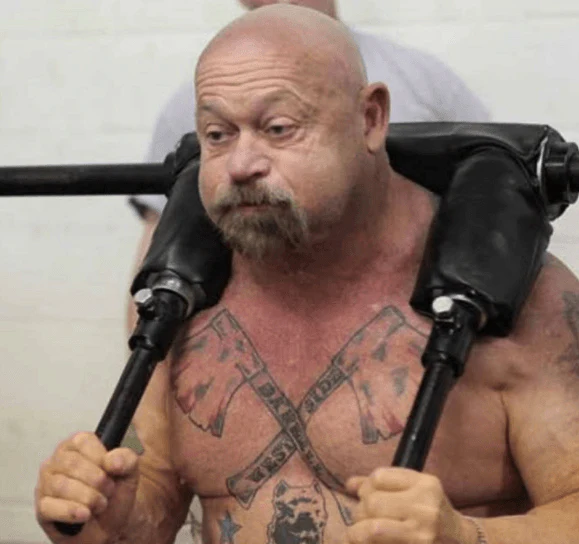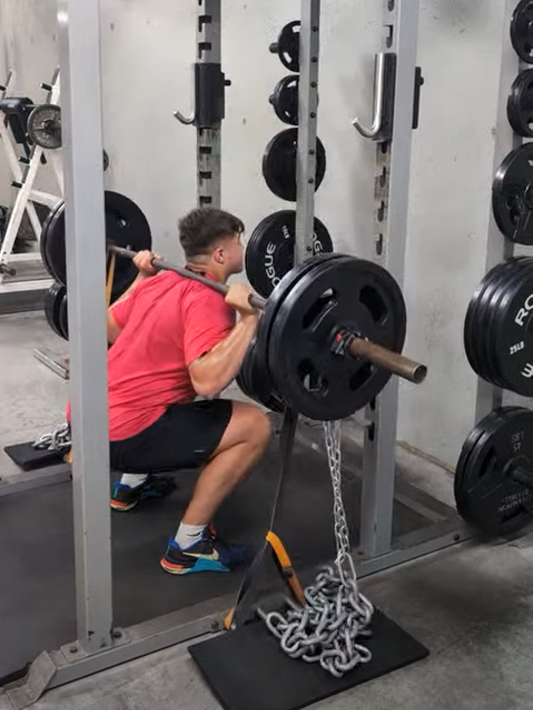Still unmatched after 30 years.
I first started using bands and chains back in 2003. Every week I would carry 60 lb of chains into the college fitness center, in my gym bag, hook them up with carabiners, then carry a pair of 100 lb dumbbells all the way to the squat rack, loop 2″ wide bands around that, and squat.
I got looked at like I was an alien.
I still remember the stare I got from the front desk guy the first time I carried them in. When they heard the chains in the bag and asked me to open it up, I could tell they wanted to ask me what the hell I was doing.
Back then nobody knew what bands or chains were, except in a hardware store. But I did. They were my secret weapons. Painstakingly searched out before Youtube or Facebook existed, I found out about them from legendary coach Louie Simmons.
The Mad Scientist of Strength

Louie Simmons wasn’t your average strength coach, and Westside Barbell sure as hell wasn’t your average gym.
Equal parts Soviet-era research junkie, powerlifting maniac, and underground innovator, Louie was the godfather of Westside Barbell, the most notorious strength lab in the world. He wasn’t just a coach, he was a mad genius with a barbell. To total “Elite” in powerlifting, your score has to rank in the top 10 of your weight class. Louie did that in 5 weight classes.
He competed across six decades from the 1960s to 2015, and is one of only 5 lifters to ever total Elite in 5 different weight classes. Totaled Elite across 4 decades. Broke his back twice, came back stronger both times, and squatted 920 pounds in his 50s. His gym’s walls are lined with more all-time world records than any other facility in existence, over 140 of them.
Louie dragged bands from the powerlifting dungeon into the spotlight for elite sport coaches. Over years, they filtered down to the rest of the fitness crowd over years. Now you can see cheap versions pitched everywhere in fitness ads to people who will never use them right.
But 25 years ago? Nobody knew what the hell they were. And today, they’re still one of the best tools for the advanced athlete to build massively explosive power with.
Why Bands and Chains Matter
Bands and chains alter the resistance curve of a lift. Normally as you stand up a squat, the lift gets easier. Instead of the bar getting easier as you stand up, it gets harder.
Chains add weight as links come off the floor. Bands stretch and pull against you the further you move the bar. The result is constant acceleration and zero coasting. If you don’t accelerate, you don’t make the lift.
Sport isn’t about struggling through slow, grindy 1RMs. It’s about force production with speed. Jumping, sprinting, cutting: all of it relies on the ability to apply force quickly, not just maximally.
If you’re an athlete, that’s everything.
Explosion off the line and first step quickness for football players, shot penetration and finishing power for wrestlers, vertical jump for all athletes… almost everything requires speed.
You don’t need max strength that only shows up when grinding through a squat in lifting shoes and a belt. You need force that’s available now. On command. Under fatigue. That’s what bands and chains train.
Bands build acceleration. Every rep is a fight from the start. No lazy bar speed allowed. Perfect for building sprint speed and explosive hip extension.
Chains reinforce control. That swaying load means no slop. Athletes have to stabilize, stay tight, and own the bar path.
Both develop intent. You can’t soft-rep your way through accommodating resistance. You either drive with violence or the bar wins.

How Should You Use Them?
Louie once said, “Weak things break.” He wasn’t just talking about muscle. He meant nervous systems, joints, movement patterns… Mindsets.
Bands and chains develop all of that. But they’re not for beginners, and they’re not for athletes who lose control of their technique when things get heavy or tiring. You absolutely have to have your head on straight and enough basic strength to be able to benefit from them.
Use bands and chains for low rep sets training explosiveness. Ideally, keep under 3 reps per set, because lifting speed tends to fall quickly after the 3rd rep. You’ll miss the point if you do sets of 5+ reps.
Weight on the bar is determined by what you can accelerate. For the majority of athletes that’s going to be between 55-75% 1RM, but in extreme cases it can be less or more. Again: the point is to be explosive, and the #1 mistake is putting too much weight on the bar. Don’t start at the top end of the range just because you want to look cool.
Total work reps stay under 15-30. That means set and rep schemes like 5-6 x 3, 8 x 2, 8 x 3, 10 x 2, or 10 x 3. The goal is to push reps faster every week: if you’re slow it means there’s too much weight or you’re too tired to use them.
Never use bands for high rep bodybuilding style sets, unless you’re a bodybuilder.
Bottom Line
Only use bands or chains on 1 lift in a session, unless you’re working under an experienced strength coach, and at most a couple workouts a week. They magnify the stress on the nervous system, which needs to be respected. Take a break from them after about 4-6 weeks. More is not better here.
Need vertical force? Band-resisted trap bar jumps. Excellent for vertical power and teaching takeoff mechanics.
Are you a thrower? Chain bench. Helps reinforce strong triceps and a snappy lockout without wrecking shoulders.
Slow starter? Speed pulls and squats with bands. Perfect for athletes who start slow or can’t finish lifts.
If you’re lifting more year after year but not getting faster, you’re leaving performance on the table. Worse, you’re just lifting like everybody else.
When you need your next plateau busted, try something different. Break out the bands. Unload the chains. And give a little nod to the madman from Columbus who saw all of this coming, decades ago.
Welcome to the deep end.

